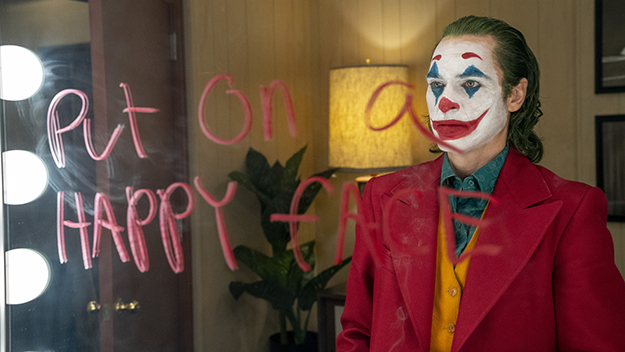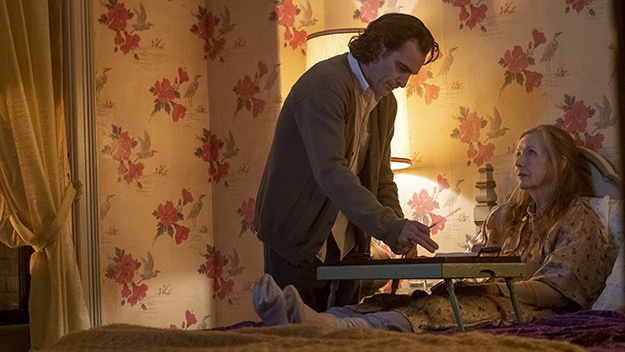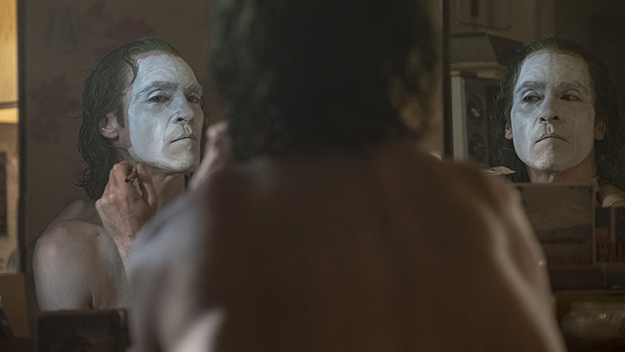Review: Joker

Images from Joker (Todd Phillips, 2019)
In the canon of onscreen violence wrought by chillingly malevolent men, two scenes loom large: Malcolm McDowell’s macabre rendition of “Singing in the Rain” in A Clockwork Orange, and Christian Bale’s axe-swinging jive to Huey Lewis and the News in American Psycho. Both graft hallmarks of innocuous spectacle onto violent assault, and as their critics aver, obscure patent immorality with the seductive tempo of fun. Of all the images that stuck after the first trailer drop for Todd Phillips’s Joker, one was strikingly familiar: Joaquin Phoenix as proto-villain Arthur Fleck, grooving to a guitar solo in a turquoise shirt, yellow vest, and a rust red suit in lieu of the usual purple, his vertiginous stage a cascading staircase on an empty city street. Joker is filled with these balletic bursts: after his first, pivotal kill, Fleck preens mesmerically in the flickering fluorescence of a grimy bathroom, framed by cinematographer Lawrence Sher in lambent greens and reds; before a big night out, he dances in his underwear while dyeing his hair that toxic, seminal green, like a teen girl mid-makeover sequence. His solo choreography might loosely bookend violence, but never actually coincides with it—a fact which has yet to deter some of the moral hand-wringing. But the derivative patina of a Sinatra-backed slo-mo reveals one of the film’s main failings: in aping the ambition and prestige of its motley influences, it winds up with a bungled understanding of its own relation to violence.
The missteps begin at inception. Where prior incarnations of the Joker have confined his characterization as Batman’s foil, Phillips’s is the first film adaptation to detail, in protracted, psychorealist devotion, the Joker’s backstory, mostly absent Bruce Wayne. In a ’70s New York–inflected Gotham of neon-flecked grime, this Joker is reanimated as Fleck, a middle-aged white man who lives with his mother and works sporadic rent-a-clown gigs. He suffers from a neurological condition that prompts convulsive bouts of laughter, caused by a brain injury from childhood abuse. Every week, he sees a state-funded psychiatrist in her cramped office, amassing RX bottles and Travis Bickle–haunted diary entries that double as joke rehearsals. He is subjected to constant violence: beat up by a group of listless brown kids in an alleyway, then a trio of drunk white yuppies on the subway; sucker-punched by a rich white man in a gilded bathroom. In Heath Ledger’s Joker of apocryphal motive and origin, there is an echo of Alan Moore’s canonical Joker monologue from The Killing Joke, largely taken to be the character’s apotheosis: “All it takes is one bad day to reduce the sanest man alive to lunacy,” goes the climactic axiom, “That’s how far the world is from where I am. Just one bad day.” That catalyst for apocalypse is singular, but Phoenix’s Fleck has only ever had bad days, the dark accrual of trauma after trauma in a life now teeming with it.

Some of Fleck’s characterization is initially compelling, but eventually struggles under its comic-franchise aegis. In the confines of a generic origin story, the tense is always future anterior: by the time of whatever plot machination, the character will have become X, will have done Y. Even the modulations that emerge in every new version of the character have a teleological drag. There is, however, the specific physicality of each new actor’s performance, and here, the way Phoenix’s body is used as a dichotomous site of revulsion and easy spectacle. The concern that Fleck’s pathologization would invite too much sympathy is, from the first shot, countervailed by the framing of Phoenix’s body as grotesque, often arced in shapes that seem to defy the very build of his skeleton, back and shoulders pocked by shadows that mark strange concavities. A palpable air of pure exertion pervades everything from Phoenix’s well-publicized weight-plummet to his near-asphyxiating contrivances of laughter: the body collapsed into its emaciated self, straining against its bare physiology. It’s a whole performance that stakes itself on corporeal self-defiance, a spectacle that repels as it enthralls.
Unlike the abstract desires of previous Jokers, circumscribed by their role as nemesis or diffused by their anarcho-nihilism, Fleck, at least initially, wants some reasonable things: not to be ostracized for his mental illness; not to be senselessly pummeled by strangers; to access his medication; not to work a shitty job for a pittance; not to live in a dysfunctional building with his mother, whose own delusions have disfigured his entire sense of self. Maybe the only desire beyond the minimal exigencies of dignified survival is Fleck’s crush on his beautiful neighbor (Zazie Beetz), a fantasy subplot so minor and anodyne it could be excised entirely (he wants kindness, affection—that, we already know). In Phillips’s construction, Fleck is less interesting as a character than a cipher for social malaise; the structural causes of his personal ills are glossed but never probed. Trash-strewn and super-rat infested, the image of Gotham’s collapsing infrastructure is an anachronistic bricolage of the urban crises that beset New York across the late ’60s and ’80s: the 1968 garbage collector strike; the clampdowns on postwar social welfare systems across the ’70s; the racist subway vigilante of ’84. Halfway through Joker, Fleck’s shrink tells him that the city has cut her funding, and leaves his medication to fate. Newspaper headlines lambast the wealthy: “GROUNDSWELL OF ANTI-RICH SENTIMENT”; “KILL THE RICH.”
On the night of his final gig as a rental clown, Fleck makes citywide headlines for a violent altercation on the subway, but only as an anonymous, clown-faced vigilante, an image soon co-opted by Gotham’s denizens for sundry causes. Fleck spends most of the film impervious to the revolutionary rhetoric ascribed to him—the legend of the clown circulates with a life of its own, and even when it returns to him, he dissociates from its symbolic import entirely. After Fleck is invited on air by talk-show host, Murray Franklin, played by Robert De Niro (in an oblique throwback to his turn as wannabe star comic in Scorsese’s The King of Comedy), he’s asked if the clown makeup donned for the night is an expression of political dissent, but Fleck demurs: “I don’t believe in that. I don’t believe in anything.” Even after he divulges his identity as the clown-faced vigilante, he stresses to an increasingly incensed studio audience that he is not political, and the subsequent boos suggest they’d be more forgiving if he actually was. At a protest outside a billionaire’s soirée, someone brandishes the sign “WE ARE ALL CLOWNS”, which briefly rings parodic but speaks to the easy recuperation of popular iconography for ideologically disparate ends.

Joker doesn’t understand its representation of violence because it doesn’t know what to do with its politics, opting instead for a confused aestheticization of anarchy à la V for Vendetta, all incendiary chants and masked malcontents thronging the streets. Somewhere, in the back of a police car, a post-Fleck Joker admires the burning vista of his gonzo orchestrations. It’s a dehistoricized rendering of protest that flattens the varied and complex history of public demonstration into photogenic rioting (though you’d be remiss to expect more from this film), and in so doing reiterates a useful point: anyone can single out an image or an object, charge it with a volt of personal animus, and resuscitate it as something else. Appropriation can be a consolatory response to structural frustrations, though there remains an obvious, mutual causality: that a mass shooter might appropriate this particular Joker for their own racist, misogynistic, anti-Semitic, ethno-nationalist aims indicts a world that has set the stage for their vitriol, as much as it does any individual film’s “responsible” representation.
The problem here might be better framed as one of media literacy. At The New York Times, Dan Brooks identifies a reductive misreading attributed, ironically, to a certain critical class. “Ostensibly too sophisticated for superhero stories, our critics have accepted the Joker’s power to corrupt the masses in real life, on a more literal level than the most addled comic-book fan ever would.” The moral concern for those susceptible masses who are bad at reading is so pervasive as to be moot: everyone is prone to decontextualizing, and co-opting cultural objects, just as Joker does, self-seriously gleaning those weightier themes from early Scorsese with only a vague sense of how to repurpose them. Towards the end, Phillips even indulges a moment of self-congratulating medium-reflexivity, with a shot of a dozen security screens, each displaying footage of prior violence, in yet another echo of shots that already happened in the ’70s. Maybe the film would’ve felt surer had it found another shape for all its references (something more playful?), one that wasn’t also cramped by the übermensch fantasies of the franchise enclosing it.
Phoebe Chen is writer and grad student living in New York.







